|
Parasitic,Saprophytic and Mycorrhizal Association.
Unlike green plants fungi lack chlorophyll and therefore must obtain their nutrition from other sources.
Fungi have an important role in the ecosystem where they break down and decompose dead plants and animals(SAPROPHYTES). Some
types of fungi attack living organisms and can be very destructive causing millions of dollars in losses to the
forestry industry. Other fungi attack living trees and even other fungi (PARASITIC).
Still others form a mutually beneficial association with trees and shrubs(MYCORRHIZA).
PARASITIC
The parasitic Lobster Mushroom,a mold which is bright orange,(below left) attacks species
of white Lactarius and Russula.
The parasitic Honey Mushroom ,below at right, attacks living trees and is extremely destructive, it spreads
by means of rhizomorphs which attach themselves to the roots of trees and once the tree has been encircled by them the
tree dies. This fungus is responsible for losses of many millions of dollars in the forestry industry.
|
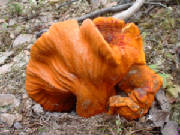
The Lobster Mushroom, Hypomyces lactifluorum.
|

The Honey Mushroom, Armillariella mellea.
|
SAPROPHYTIC.
|
|
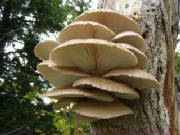
|
| Oyster Mushroom,Pleurotus ostreatus. |
Fungi that are saprophytes grow on dead organic material, this would include leaves,grass,dung and
dead wood amongst others. Some saprophytes will only grow on specific decaying matter and it is this exclusivity that
helps us in our quest to find mushrooms of a particular species. For example The Oyster Mushroom,Pleurotus ostreatus(at
left) has a particular liking for dead wood, particularly hardwoods.
.
MYCORRHIZAL ASSOCIATION.

|
| The King Bolete,Boletus edulis. |
Lastly,but probably the most interesting is the mutually beneficial Mycorrhizal Association.
The vegetative part of the fungus, known as the mycelium, penetrates and also wraps itself around the tiny rootlets
of trees and shrubs. This does the plant no harm and in fact both the fungus(mushroom) and the plant derive benefit from this
symbiosis. The tree obtains Nitrogen,Phosphorous and other nutrients from the mushroom. The mushroom on the other hand derives
moisture and carbohydrates from the tree. Trees that do not have this mycorrhizal relationship do not fare as well as
trees that do. In many cases the fungus is incapable of existing as a saprophyte or as a parasite but instead must have the
living host. In the photograph above I have found that The King Bolete, Boletus edulis must form a symbiotic
relationship with spruce trees that are in the region of 20 years old or more.
Click here to go back to Nova Scotia Orchids.
DECORTICATED WOOD.
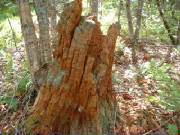
|
| Decorticated Wood. |
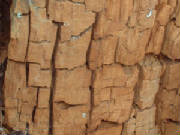
|
| Closeup of Decorticated Wood. |
Fungi are extremely good at rotting wood. Shown immediately above is a stump that
has been attacked by fungi along it's lines of least resistance. In a larger tree the lines will appear to be exaggerated
and extend about the trees circumference giving an appearance that the wood has split in to cubes. This is known as cubic
rot.
THE FAIRY RING.
When you see a Fairy Ring what you are actually seeing is akin to seeing an apple
on a tree. The mushroom is the fruit of the organism below the ground that you can't see. This organism is known
as Mycelium.
So how did the Mycelium get there?
All mushrooms produce spores in the millions and they are dispersed in different
ways. Many are carried off by the wind to land in a spot that has to be an "ideal" place to germinate. Humidity,temperature,substrate
etc, all these things play a role in the successful germination of a spore. Once the spores germinate they develop in to
hyphae. The hyphae are a mass of extremely small threadlike strands that are collectively known as Mycelium.
The Mycelium then begins to take in nourishment from the surrounding organic material. Then once the conditions are
right the mycelium will produce fruiting bodies,the mushroom.The mushrooms then emerge on the surface and the reproductive
process starts all over again.
As the mycelium at the centre of the ring exhausts it's food supply and dies out the mycelium
at the outer edges of the ring pushes it's way outwards in search of nourishment. That is why the fairy ring
increases it's diameter year after year.
Almost any ground dwelling (terrestrial) mushroom can form a fairy ring.However, the ones which
most often form fairy rings belong to the genera Amanita,Agaricus and Lepiota. The photographs below
show The Horse Mushroom, Agaricus arvensis in a fairy ring and also in close up.
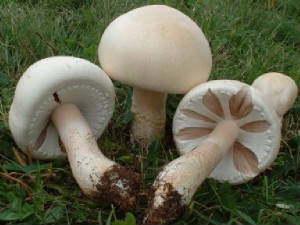
|
| Horse Mushroom, Agaricus arvensis. |
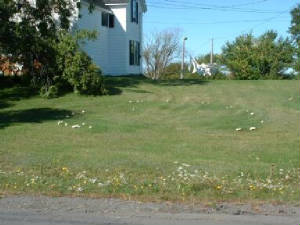
|
| Fairy Ring,Horse Mushroom. Agaricus arvensis. |
|




